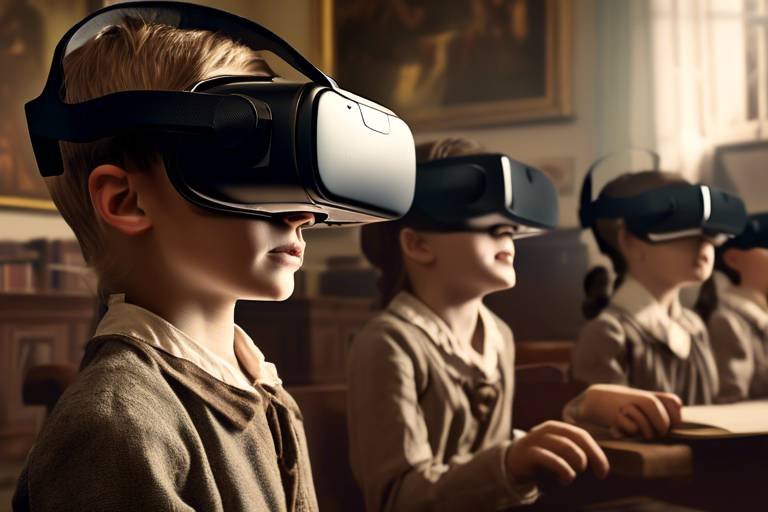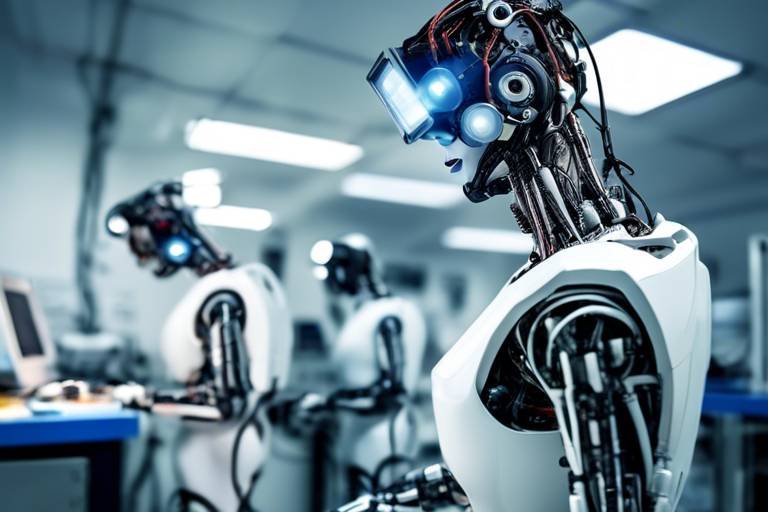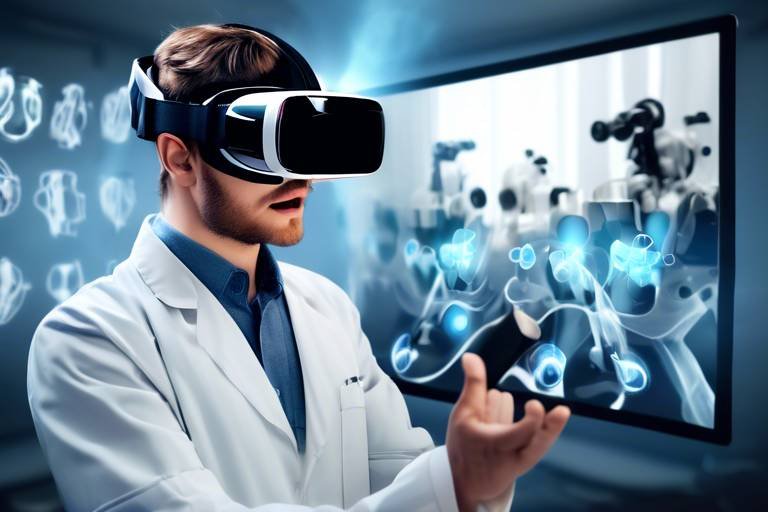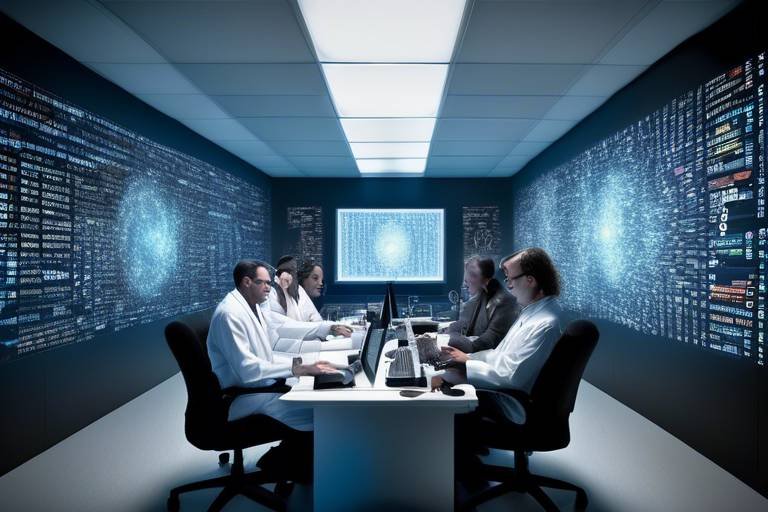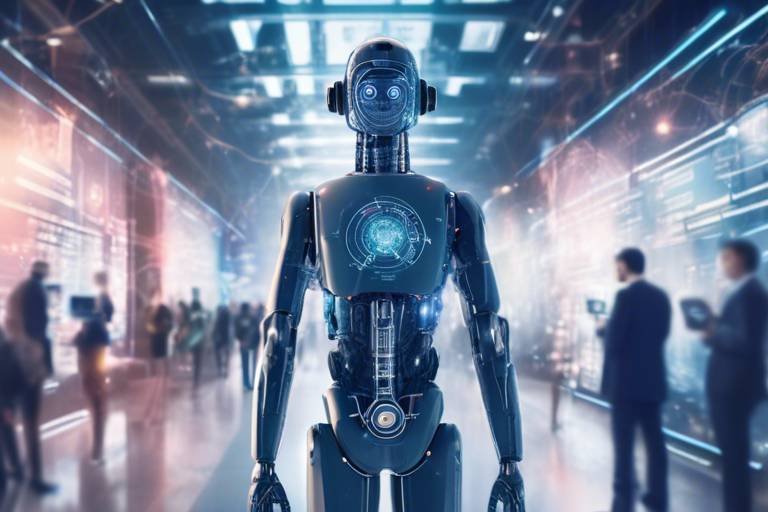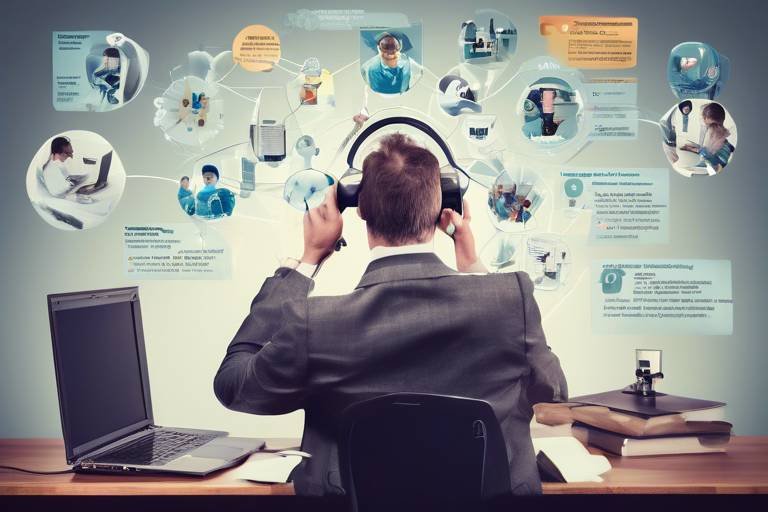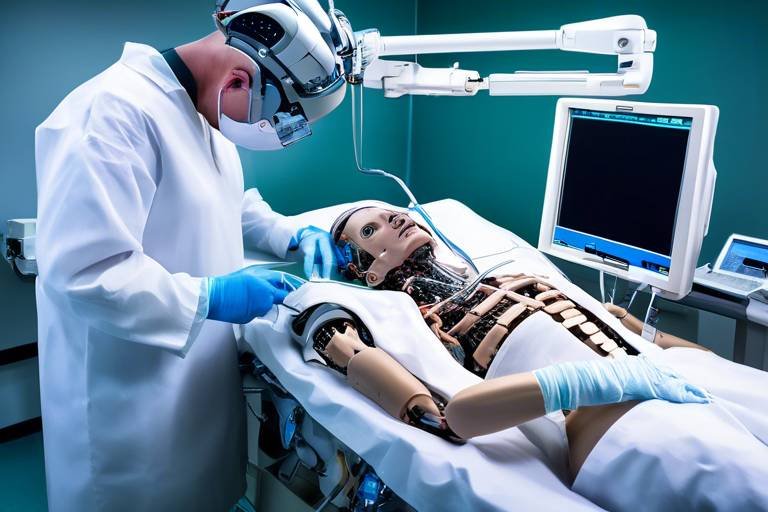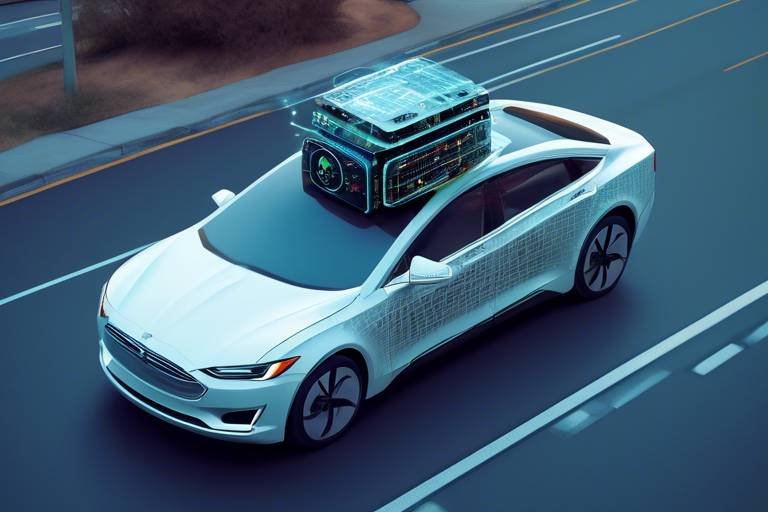How Virtual Reality is Improving Historical Education
In today’s fast-paced world, traditional methods of teaching history often fall short in capturing the imagination of students. Enter Virtual Reality (VR)—a game-changer that is transforming how we engage with the past. Imagine donning a headset and suddenly finding yourself in the midst of a bustling ancient marketplace, or standing on the battlefield during a pivotal moment in history. This isn't just a dream; it's the reality that VR offers to students, making learning an unforgettable experience.
With VR, the classroom becomes a portal to different times and places, allowing students to interact with history in ways that textbooks simply cannot provide. Instead of reading about the signing of the Declaration of Independence, students can virtually witness the event, feeling the tension and excitement of that moment. This immersive learning experience not only enhances understanding but also fosters a deep emotional connection to historical events.
Furthermore, VR encourages active participation. Students are not just passive recipients of information; they become explorers of history. They can engage in interactive simulations that challenge them to think critically and make decisions based on historical contexts. For instance, they might find themselves negotiating peace treaties or navigating the complexities of ancient civilizations, all while learning valuable lessons about cause and effect.
One of the most exciting aspects of VR in historical education is the opportunity for virtual field trips. Imagine your students “visiting” the pyramids of Egypt or the ruins of Pompeii without ever leaving the classroom. These experiences can spark curiosity and ignite a passion for history that textbooks alone may not inspire. By experiencing these sites firsthand, students can better appreciate the significance of these historical landmarks and the stories they tell.
Moreover, VR facilitates role-playing scenarios that allow students to step into the shoes of historical figures. This unique approach promotes empathy and understanding, as students grapple with the challenges and decisions faced by these individuals. They might find themselves in the role of a civil rights leader fighting for justice or a scientist making groundbreaking discoveries. Such experiences not only enhance their learning but also help them to develop a personal connection to the past.
Another vital aspect of VR is its potential for accessibility and inclusivity. With various learning styles and needs among students, VR can accommodate these differences effectively. Visual learners benefit from immersive visuals, while kinesthetic learners thrive in interactive environments. This adaptability ensures that every student has the opportunity to engage with history in a meaningful way, breaking down barriers that traditional education methods often create.
As schools consider the implementation of VR technology, it is essential to recognize its cost-effectiveness. While the initial investment in VR equipment may seem high, the long-term benefits can far outweigh the costs. By reducing the need for physical materials and resources, schools can allocate their budgets more efficiently. In the long run, VR can provide a wealth of historical content and experiences all in one platform, making it a smart investment for educational institutions.
Ultimately, the long-term benefits of integrating VR into historical education are profound. Improved retention rates, heightened engagement, and a greater appreciation for history contribute to shaping informed and engaged future citizens. By immersing students in the past, we are not just teaching them history; we are inspiring them to become active participants in shaping the future.
- What is Virtual Reality? VR is a computer-generated environment that allows users to interact with a 3D space, often using headsets and controllers.
- How does VR enhance historical education? VR provides immersive experiences that engage students and promote deeper understanding and retention of historical events.
- Is VR accessible for all students? Yes, VR can cater to various learning styles, making history education more inclusive.
- What are the long-term benefits of using VR in education? Long-term benefits include improved retention rates, increased engagement, and a greater appreciation for history.

Immersive Learning Experiences
Virtual reality (VR) is revolutionizing the way we approach education, particularly in the field of history. Imagine stepping into a time machine, where the walls of your classroom dissolve, and you find yourself standing amidst the bustling streets of Ancient Rome or witnessing the signing of the Declaration of Independence. This is the power of immersive learning experiences. Unlike traditional teaching methods that often rely heavily on textbooks and lectures, VR allows students to experience history firsthand, creating a vivid tapestry of sights, sounds, and emotions that textbooks simply cannot convey.
In a VR environment, students are not just passive recipients of information; they become active participants. They can walk through historical landmarks, interact with digital reconstructions of significant events, and even engage with virtual characters who represent historical figures. This level of engagement transforms the learning process into an adventure, making it more memorable and impactful. For instance, a student learning about the Civil War could don a VR headset and find themselves on a battlefield, hearing the sounds of cannon fire and the cries of soldiers. Such experiences make history feel alive, fostering a deeper understanding and appreciation of the events that shaped our world.
Moreover, the immersive nature of VR can accommodate various learning styles. Visual learners can benefit from the stunning graphics and visual storytelling, while auditory learners can absorb information through dialogues and soundscapes. Kinesthetic learners, on the other hand, can engage physically by moving around and interacting with the environment. This multi-sensory approach not only enhances retention but also ensures that all students, regardless of their preferred learning style, can connect with historical content in a meaningful way.
Additionally, VR can facilitate collaborative learning experiences. Students can join their peers in virtual environments, working together to solve historical puzzles or reenact significant events. This collaboration not only promotes teamwork but also encourages discussion and debate, helping students to develop critical thinking skills. Imagine a classroom where students are not just learning about history but are actively reshaping it together! The potential for engagement and learning is limitless.
As we continue to explore the benefits of VR in historical education, it's clear that immersive learning experiences are not just a trend; they are a transformative approach that can ignite a passion for history in students. By allowing them to engage with the past in ways that are not only educational but also exhilarating, we are paving the way for a new generation of informed, empathetic, and engaged citizens.

Enhanced Engagement
In today's fast-paced world, capturing the attention of students can feel like an uphill battle. Traditional teaching methods often struggle to hold the interest of a generation raised on interactive technology. Enter Virtual Reality (VR), a game-changer in the realm of historical education. With its ability to immerse students in a lifelike environment, VR transforms passive learning into an engaging adventure. Imagine being able to walk through ancient Rome, hear the bustling market sounds, or witness a pivotal moment in history as if you were really there. This level of engagement is not just a fantasy; it’s becoming a reality in classrooms around the globe.
By utilizing VR, educators can foster a deeper interest in history among students. Instead of merely reading about events in textbooks, students can actively participate in them. This hands-on approach not only makes learning more enjoyable but also encourages active participation. When students are engaged, they are more likely to retain information, leading to improved academic performance. Think of it as the difference between watching a movie and being an actor in it—one is entertaining, but the other is transformative.
Furthermore, VR can bridge the gap between different learning styles. Some students may excel through visual learning, while others may benefit from auditory or kinesthetic methods. VR accommodates these diverse preferences by providing a multi-sensory experience. For instance, while exploring a historical event, students can see, hear, and even interact with their surroundings. This holistic approach not only enhances understanding but also makes learning more inclusive.
To illustrate how VR enhances engagement, consider the following aspects:
- Real-Time Interaction: Students can ask questions and receive immediate feedback, creating a dynamic learning environment.
- Peer Collaboration: VR allows students to work together in virtual spaces, fostering teamwork and communication skills.
- Gamification: Incorporating game-like elements into historical lessons can motivate students to explore and learn more.
In summary, the enhanced engagement provided by VR is revolutionizing historical education. By immersing students in interactive simulations, they gain a deeper appreciation for history and develop critical thinking skills. The excitement of stepping into the past not only makes learning enjoyable but also cultivates a generation of informed and passionate historians.
- How does VR improve historical education?
VR provides immersive experiences that allow students to engage with historical events in a way that traditional methods cannot replicate. - Is VR accessible for all students?
Yes, VR can accommodate various learning styles and needs, making historical education more inclusive. - What are the long-term benefits of using VR in education?
Long-term benefits include improved retention rates and a greater appreciation for history, shaping informed and engaged future citizens.

Interactive Simulations
Imagine stepping into a time machine and finding yourself right in the middle of a pivotal moment in history. powered by virtual reality (VR) make this dream a reality, allowing students to engage with historical events in a way that traditional textbooks simply cannot match. Instead of passively reading about the American Revolution or the signing of the Magna Carta, students can actively participate in these events, walking through the streets of colonial America or standing in the great hall of Runnymede. This hands-on approach not only captivates their imagination but also helps solidify their understanding of complex historical contexts.
What sets interactive simulations apart is their ability to immerse students in scenarios where they can make decisions and see the consequences of those decisions unfold in real-time. For instance, a simulation of a World War II battle might allow students to take on the role of a commander, strategizing troop movements and adapting to the changing tides of war. This level of engagement fosters a sense of ownership over their learning experience, making history feel less like a series of dates and events and more like a living, breathing narrative.
Furthermore, these simulations can be tailored to accommodate different learning styles. Visual learners can benefit from rich graphics and animations, while auditory learners can engage with historical figures through dialogue and sound effects. Kinesthetic learners, on the other hand, thrive in environments where they can physically interact with the content. By catering to these diverse needs, interactive simulations ensure that every student has the opportunity to connect with history on a personal level.
Additionally, the use of encourages collaboration among students. Working together to solve problems or navigate historical challenges not only enhances their social skills but also deepens their understanding of the subject matter. Group discussions following these simulations can lead to rich conversations about the moral and ethical implications of historical events, further enhancing critical thinking skills.
In conclusion, the power of interactive simulations in VR is revolutionizing how we teach history. By immersing students in these dynamic learning environments, we are not only making history more engaging but also ensuring that the lessons learned resonate long after the simulation ends. With every virtual experience, students are not just observing history; they are becoming a part of it.
- What are interactive simulations in virtual reality? Interactive simulations in VR allow students to engage with historical events in a hands-on manner, enabling them to make decisions and experience the outcomes of those decisions in real-time.
- How do these simulations enhance learning? By immersing students in historical contexts, interactive simulations foster engagement, promote critical thinking, and accommodate diverse learning styles.
- Can interactive simulations be tailored for different learning styles? Yes! These simulations can include visual, auditory, and kinesthetic elements to cater to various learning preferences.
- What are the benefits of using VR in history education? Benefits include increased engagement, improved retention rates, enhanced critical thinking skills, and the ability to foster empathy through role-playing scenarios.

Virtual Field Trips
This article explores the transformative role of virtual reality (VR) in enhancing historical education, engaging students in immersive experiences that deepen their understanding of historical events and contexts.
Virtual reality creates immersive environments where students can experience history firsthand, allowing them to engage with historical events in a way that traditional methods cannot replicate.
By utilizing VR, educators can capture students' attention more effectively, fostering a deeper interest in history and encouraging active participation in the learning process.
VR offers interactive simulations that allow students to explore historical events, providing a hands-on approach to learning that enhances retention and understanding.
Imagine being able to walk through the streets of ancient Rome or stand in the middle of a bustling marketplace during the Renaissance—all from the comfort of your classroom. make this possible by transporting students to significant historical sites around the globe. These immersive experiences not only spark curiosity but also allow students to visualize and contextualize what they learn in textbooks.
With VR, students can explore landmarks such as the Great Wall of China, the pyramids of Egypt, or even the battlefields of World War II. This kind of engagement is unparalleled. Instead of merely reading about these places, students can interact with them, gaining a deeper understanding of their historical significance. For instance, while visiting the ruins of Pompeii, students can see the remnants of the volcanic eruption that buried the city, helping them grasp the magnitude of the event.
Moreover, virtual field trips can be tailored to fit various educational needs and interests. Teachers can select specific historical periods or events to focus on, ensuring that the content aligns with their curriculum. This flexibility allows for a more personalized learning experience. Here are some key benefits of virtual field trips:
- Cost-Effectiveness: Traditional field trips often come with high costs for transportation and admission fees. VR eliminates these expenses.
- Accessibility: Students who may not be able to travel due to physical limitations or financial constraints can still experience these historical sites.
- Safety: Students can explore potentially hazardous locations without any real-world risks.
In conclusion, virtual field trips are revolutionizing the way we teach history. They allow students to engage with the past in a way that is both exciting and educational, making history come alive like never before.
Virtual reality can make historical education more accessible to diverse learners, accommodating various learning styles and needs, ensuring that all students can engage with history.
Implementing VR in historical education can be cost-effective in the long run, reducing the need for physical materials and resources while providing rich educational experiences.
Schools can allocate resources more efficiently by investing in VR technology, which can offer a wide range of historical content and experiences in one platform.
The long-term benefits of VR in historical education include improved retention rates and a greater appreciation for history, shaping informed and engaged future citizens.
- What is virtual reality? Virtual reality is a simulated experience that can be similar to or completely different from the real world, often using VR headsets to immerse users in a 3D environment.
- How does VR enhance historical education? VR enhances historical education by providing immersive experiences that allow students to explore historical events and locations interactively.
- Are virtual field trips expensive? No, virtual field trips can be more cost-effective than traditional field trips, as they eliminate transportation and admission fees.
- Can all students benefit from VR? Yes, VR can accommodate various learning styles and needs, making historical education more inclusive and accessible.

Role-Playing Scenarios
Imagine stepping into the shoes of a historical figure, feeling the weight of their decisions and the impact of their actions. in virtual reality (VR) offer students a unique opportunity to do just that. These immersive experiences allow learners to embody characters from different eras, creating a profound connection to the past that traditional textbooks simply can't provide. When students engage in role-playing, they don’t just learn history; they live it. This hands-on approach fosters a deeper understanding of historical contexts and the complexities of human experiences.
For instance, a student might find themselves in the midst of the American Revolution, taking on the role of a soldier or a leader. They can experience the tension and excitement of battle, the camaraderie among troops, or the strategic planning that goes into a successful campaign. This kind of engagement not only makes history memorable but also encourages critical thinking as students navigate the challenges faced by their characters. They must consider questions like, "What would I do in this situation?" or "How would my decisions affect others?"
Moreover, role-playing scenarios can be tailored to accommodate various learning styles, making history accessible and engaging for all students. Visual learners can benefit from the vivid imagery of VR, while kinesthetic learners can grasp concepts through movement and interaction. This versatility is crucial in today's diverse classrooms, where students come with different backgrounds and learning preferences.
To further illustrate the benefits of role-playing in VR, consider the following:
| Benefit | Description |
|---|---|
| Empathy Building | Students gain a personal connection to historical figures, fostering empathy and understanding of diverse perspectives. |
| Critical Thinking | Role-playing encourages students to analyze situations and make decisions, enhancing their critical thinking skills. |
| Collaboration | Many role-playing scenarios can involve group activities, promoting teamwork and communication among students. |
In a world where history often feels distant and detached, role-playing scenarios in VR breathe life into the past. They transform students from passive recipients of information into active participants in history. This shift not only makes learning more enjoyable but also cultivates a generation of learners who are informed, empathetic, and engaged with the world around them.
As we continue to explore the potential of VR in education, it’s clear that role-playing scenarios will play a pivotal role in shaping how we teach and understand history. With each virtual experience, students are not just learning about the past; they are becoming a part of it, ensuring that history is not forgotten but rather celebrated and understood.
- What is virtual reality in education? Virtual reality in education refers to the use of VR technology to create immersive learning experiences that engage students in a dynamic way.
- How does role-playing in VR enhance learning? Role-playing in VR allows students to experience historical events and decisions firsthand, fostering empathy, critical thinking, and a deeper understanding of the subject matter.
- Is VR accessible for all students? Yes, VR can accommodate various learning styles and needs, making historical education more inclusive and engaging for diverse learners.
- What are the long-term benefits of using VR in historical education? Long-term benefits include improved retention rates, greater appreciation for history, and the development of informed, engaged citizens.

Accessibility and Inclusivity
When we think about education, one of the biggest challenges is ensuring that every student has the opportunity to learn in a way that suits them best. This is where virtual reality (VR) shines like a beacon, offering a unique solution to the age-old problem of accessibility in historical education. Imagine a classroom where every student, regardless of their learning style or physical ability, can engage with history in a meaningful way. Sounds like a dream, right? Well, with VR, this dream is becoming a reality.
One of the most remarkable aspects of VR is its ability to cater to diverse learning needs. Traditional teaching methods often fall short for students who may struggle with reading or auditory learning. However, VR transcends these barriers by providing visual and interactive experiences. For instance, students with dyslexia can fully immerse themselves in a historical event without the anxiety of text-heavy materials. They can see, hear, and even interact with the environment, making history not just a subject in a textbook, but a vivid experience that they can grasp.
Moreover, VR can be particularly beneficial for students with physical disabilities. Imagine a student in a wheelchair who dreams of exploring the ancient ruins of Rome. With VR, they can navigate these historical sites from the comfort of their classroom, experiencing the grandeur of history without the physical limitations that would typically hold them back. This level of inclusivity ensures that no student is left behind, fostering a sense of belonging and engagement that is often missing in conventional educational settings.
Additionally, VR can accommodate various learning styles. Some students are visual learners, while others may learn best through hands-on experiences. With VR, educators can create tailored experiences that cater to these different styles. For example, a history lesson on the American Revolution can be transformed into a VR experience where students can witness the Boston Tea Party unfold before their eyes, allowing visual learners to thrive. Meanwhile, kinesthetic learners can engage in role-playing scenarios, stepping into the shoes of historical figures and acting out pivotal moments in history.
Furthermore, the potential for global access is another exciting aspect of VR. Students from different backgrounds and regions can connect and share their experiences, breaking down geographical and cultural barriers. Imagine students in a small town in the Midwest collaborating with peers in a bustling city in Europe, all while exploring the same historical event through VR. This not only enhances their understanding of history but also cultivates a sense of global citizenship.
In conclusion, the offered by virtual reality in historical education is not just a bonus; it's a game-changer. By embracing VR technology, we can create an educational landscape where every student has the opportunity to engage with history in a way that resonates with them. As we continue to explore the potential of VR, we must remember that education should be a bridge, not a barrier—one that connects us all through the rich tapestry of our shared history.
- How does VR enhance learning for students with disabilities?
VR provides immersive experiences that cater to various learning styles, helping students with disabilities engage with historical content in ways that traditional methods cannot. - Can VR be used in all subjects, or just history?
While this article focuses on history, VR has applications across many subjects, including science, geography, and the arts, enhancing education in diverse fields. - What are the costs associated with implementing VR in the classroom?
While initial costs can be high, VR can be cost-effective over time by reducing the need for physical materials and providing a wide range of educational experiences in one platform. - Is VR suitable for all age groups?
Yes, VR can be adapted for various age groups, making it a versatile tool for engaging learners from elementary school to higher education.

Cost-Effectiveness
When it comes to educational tools, the initial investment can often seem daunting. However, implementing virtual reality (VR) in historical education can actually prove to be quite cost-effective over time. While the upfront costs of VR technology, including headsets and software, might raise eyebrows, the long-term savings and benefits can significantly outweigh these expenses. Think of it like buying a high-quality book that you can use year after year, versus a single-use worksheet. The key is in understanding how VR can transform the learning experience while also being a smart financial choice.
First and foremost, consider the reduction in physical materials. Traditional history classes often rely on textbooks, maps, and other printed resources. These materials not only accumulate costs but also require regular updates to stay relevant. In contrast, VR platforms can house a vast array of historical content in a single, dynamic environment. This means that instead of purchasing new textbooks every year, schools can invest in a VR system that can be updated with the latest historical simulations and experiences with just a software update.
Moreover, VR can significantly reduce the costs associated with field trips. Organizing a field trip to a historical site involves transportation, entry fees, and often, additional staffing. With VR, students can embark on virtual field trips to places like the Colosseum in Rome or the Pyramids of Giza from the comfort of their classroom. This not only eliminates the logistical nightmares and expenses of real-world excursions but also allows for unlimited exploration of numerous sites without the associated costs.
Another important aspect to consider is resource allocation. Schools often operate under tight budgets, and investing in VR technology can allow for more efficient use of funds. Instead of spreading resources thin across multiple subjects and materials, a single VR platform can offer a comprehensive library of historical experiences. This means that educators can not only teach history but also integrate it with subjects like geography and art, all while using the same technology.
Additionally, the long-term benefits of engaging students through VR can lead to improved retention rates and better academic performance. When students are genuinely interested and actively participating in their learning, they are more likely to remember what they learn. This translates into higher test scores and a deeper understanding of historical contexts, which is invaluable for shaping informed citizens of the future.
| Cost Comparison | Traditional Methods | VR Implementation |
|---|---|---|
| Initial Setup Cost | High (textbooks, materials) | Moderate (VR headsets, software) |
| Annual Maintenance Cost | High (new materials, updates) | Low (software updates) |
| Field Trip Costs | High (transportation, fees) | Minimal (virtual experience) |
| Engagement Levels | Variable | High (immersive experiences) |
In conclusion, while the idea of adopting new technology can be overwhelming, the cost-effectiveness of virtual reality in historical education is clear. By reducing ongoing expenses, enhancing engagement, and providing a more enriching learning environment, VR not only makes financial sense but also paves the way for a brighter, more informed future for students.
- What is the initial cost of VR technology for schools? The initial cost can vary widely depending on the hardware and software chosen, but many schools find it a worthwhile investment considering the long-term savings.
- Can VR replace traditional teaching methods? While VR offers unique advantages, it is best used as a complement to traditional methods, enhancing the overall learning experience.
- How can VR be integrated into the existing curriculum? Educators can incorporate VR experiences into lesson plans, using them to illustrate historical events and contexts that align with their curriculum goals.

Resource Allocation
When it comes to implementing virtual reality (VR) in historical education, plays a pivotal role. Schools often face tight budgets, and they need to ensure that every dollar spent contributes to enhancing the learning experience for students. By investing in VR technology, educational institutions can streamline their resource allocation in several impactful ways. First and foremost, VR platforms can house a myriad of historical content, allowing teachers to access a wealth of resources without the need for multiple physical materials. Imagine a single VR headset being able to transport students to ancient Rome, the American Revolution, or even the Renaissance—all with just a few clicks!
Moreover, the cost of traditional educational resources—like textbooks, maps, and physical field trips—can quickly add up. Schools can reallocate funds from these areas into VR technology, which not only provides a more engaging learning environment but also reduces long-term expenses. For instance, a single investment in a VR system can replace the need for expensive field trips or multiple textbooks, allowing schools to stretch their budgets further while offering students an immersive experience that textbooks simply cannot provide.
To illustrate this point, consider the following table that compares traditional resources with VR technology in terms of cost and engagement:
| Resource Type | Estimated Cost | Engagement Level |
|---|---|---|
| Textbooks | $100 per student | Low |
| Field Trips | $500 per trip | Medium |
| VR Technology | $300 per headset (one-time cost) | High |
As the table shows, while the initial investment in VR might seem significant, the long-term benefits and savings are undeniable. Schools can utilize VR to create rich, interactive lessons that cater to various learning styles, ensuring that every student has the opportunity to engage with history in a meaningful way. This approach not only enhances educational outcomes but also prepares students for a future where technology plays an integral role in their learning journey.
In summary, effective resource allocation towards virtual reality in historical education is not just a smart financial decision; it's a transformative strategy that can revolutionize how students learn about the past. By embracing this technology, schools can provide an enriched educational experience that fosters curiosity and a deeper understanding of history.
- What is virtual reality in education? Virtual reality in education refers to the use of immersive technology to create realistic simulations and environments for learning purposes.
- How can VR enhance historical education? VR can enhance historical education by providing immersive experiences that allow students to engage with historical events and figures in a way that traditional methods cannot.
- Is VR cost-effective for schools? Yes, while the initial investment may be higher, VR can save schools money in the long run by reducing the need for physical materials and offering a wide range of educational experiences.
- Can VR accommodate different learning styles? Absolutely! VR can cater to visual, auditory, and kinesthetic learners, making historical education more accessible and inclusive.

Long-Term Benefits
When we think about the of integrating virtual reality (VR) into historical education, it’s like looking through a time machine that not only shows us the past but also shapes our future. Imagine students who are not just passive recipients of information but are actively engaged in their learning process. This immersive approach fosters a deeper understanding of historical events, allowing students to retain knowledge significantly better than through traditional learning methods. Research indicates that when students participate in VR experiences, they can recall facts and details more effectively, leading to improved retention rates.
Moreover, VR cultivates a genuine appreciation for history. Instead of merely memorizing dates and events, students can experience the emotions and contexts of the past. This emotional connection transforms history lessons into vivid narratives that resonate with learners on a personal level. When students step into the shoes of historical figures or witness pivotal moments, they develop a sense of empathy and understanding that textbooks alone cannot provide. This emotional engagement encourages students to think critically about the past, fostering informed discussions about how history shapes our present and future.
Another significant advantage of VR in historical education is its potential to create informed and engaged citizens. By immersing students in realistic scenarios, they learn to analyze historical events from multiple perspectives. This critical thinking skill is essential in today’s world, where understanding different viewpoints is crucial for civic engagement and social responsibility. As students learn about the complexities of history, they become more equipped to tackle contemporary issues with a nuanced understanding of their roots.
Let’s not forget the cost-effectiveness of implementing VR technology in schools. While the initial investment may seem daunting, the long-term savings on physical materials, field trips, and other resources can be substantial. Schools can allocate their budgets more efficiently by investing in VR platforms that provide a wide array of historical content, making it easier to update and expand the curriculum without the need for constant physical resources.
In summary, the long-term benefits of virtual reality in historical education extend far beyond the classroom. By enhancing retention rates, fostering empathy, and promoting critical thinking, VR not only enriches the learning experience but also prepares students to be thoughtful, engaged citizens in a complex world. Ultimately, the integration of VR technology is more than just a trend; it’s a transformative approach that can redefine how we teach and learn about history.
- What is virtual reality in education?
Virtual reality (VR) in education refers to the use of immersive technologies to create interactive learning environments where students can engage with content in a hands-on manner.
- How does VR improve historical education?
VR enhances historical education by providing immersive experiences, allowing students to witness and interact with historical events, which leads to better retention and understanding.
- Are there any downsides to using VR in education?
While VR offers numerous benefits, challenges include the cost of technology, the need for proper training for educators, and potential technical issues during implementation.
- Is VR accessible for all students?
VR can be made accessible to diverse learners by accommodating different learning styles and needs, but it requires thoughtful implementation and resources.
Frequently Asked Questions
- How does virtual reality enhance historical education?
Virtual reality (VR) enhances historical education by creating immersive environments where students can experience historical events firsthand. This engagement allows learners to interact with history in a way that traditional methods simply can't replicate, making the learning process more impactful and memorable.
- What are some examples of immersive learning experiences in VR?
Examples of immersive learning experiences in VR include virtual field trips to historical sites, where students can explore places like ancient Rome or the pyramids of Egypt without leaving their classroom. Additionally, role-playing scenarios let students step into the shoes of historical figures, promoting empathy and a deeper personal connection to the past.
- Can VR accommodate different learning styles?
Absolutely! VR is designed to be inclusive, catering to various learning styles and needs. Whether a student learns best through visual, auditory, or kinesthetic methods, VR can provide tailored experiences that engage all types of learners, ensuring that history is accessible to everyone.
- Is implementing VR in schools cost-effective?
Yes, implementing VR can be cost-effective in the long run. While the initial investment in technology may seem high, schools can save on physical materials and resources. VR platforms can offer a wide range of historical content, which means less spending on textbooks and field trips over time.
- What are the long-term benefits of using VR in historical education?
The long-term benefits of using VR in historical education include improved retention rates and a greater appreciation for history among students. By providing engaging and interactive experiences, VR helps shape informed and engaged future citizens who are more likely to value and understand historical contexts.

